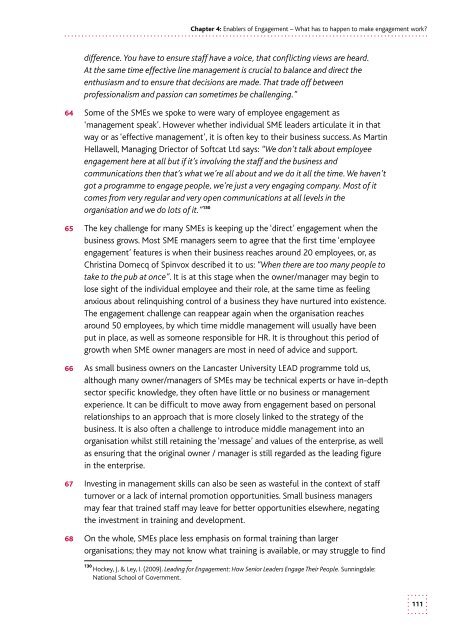3ytgeaf
3ytgeaf
3ytgeaf
Create successful ePaper yourself
Turn your PDF publications into a flip-book with our unique Google optimized e-Paper software.
Chapter 4: Enablers of Engagement – What has to happen to make engagement work<br />
difference. You have to ensure staff have a voice, that conflicting views are heard.<br />
At the same time effective line management is crucial to balance and direct the<br />
enthusiasm and to ensure that decisions are made. That trade off between <br />
professionalism and passion can sometimes be challenging.”<br />
64 Some of the SMEs we spoke to were wary of employee engagement as<br />
‘management speak’. However whether individual SME leaders articulate it in that<br />
way or as ‘effective management’, it is often key to their business success. As Martin<br />
Hellawell, Managing Driector of Softcat Ltd says: “We don’t talk about employee<br />
engagement here at all but if it’s involving the staff and the business and<br />
communications then that’s what we’re all about and we do it all the time. We haven’t<br />
got a programme to engage people, we’re just a very engaging company. Most of it<br />
comes from very regular and very open communications at all levels in the<br />
organisation and we do lots of it.” 130<br />
65 The key challenge for many SMEs is keeping up the ‘direct’ engagement when the<br />
business grows. Most SME managers seem to agree that the first time ‘employee<br />
engagement’ features is when their business reaches around 20 employees, or, as<br />
Christina Domecq of Spinvox described it to us: “When there are too many people to<br />
take to the pub at once”. It is at this stage when the owner/manager may begin to<br />
lose sight of the individual employee and their role, at the same time as feeling<br />
anxious about relinquishing control of a business they have nurtured into existence.<br />
The engagement challenge can reappear again when the organisation reaches<br />
around 50 employees, by which time middle management will usually have been<br />
put in place, as well as someone responsible for HR. It is throughout this period of<br />
growth when SME owner managers are most in need of advice and support.<br />
66 As small business owners on the Lancaster University LEAD programme told us,<br />
although many owner/managers of SMEs may be technical experts or have in-depth<br />
sector specific knowledge, they often have little or no business or management<br />
experience. It can be difficult to move away from engagement based on personal<br />
relationships to an approach that is more closely linked to the strategy of the<br />
business. It is also often a challenge to introduce middle management into an<br />
organisation whilst still retaining the ‘message’ and values of the enterprise, as well<br />
as ensuring that the original owner / manager is still regarded as the leading figure<br />
in the enterprise.<br />
67 Investing in management skills can also be seen as wasteful in the context of staff<br />
turnover or a lack of internal promotion opportunities. Small business managers<br />
may fear that trained staff may leave for better opportunities elsewhere, negating<br />
the investment in training and development.<br />
68 On the whole, SMEs place less emphasis on formal training than larger<br />
organisations; they may not know what training is available, or may struggle to find<br />
130<br />
Hockey, J, & Ley, I. (2009). Leading for Engagement: How Senior Leaders Engage Their People. Sunningdale:<br />
National School of Government.<br />
111


